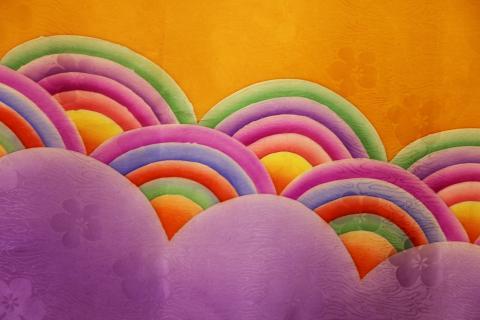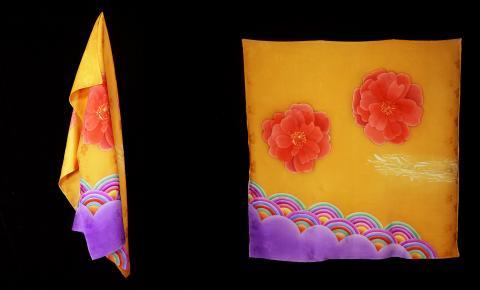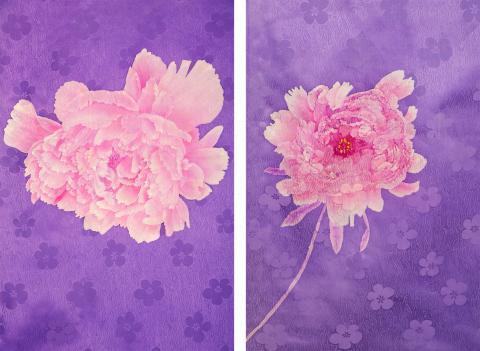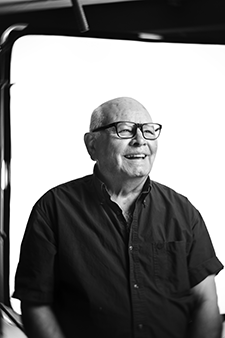2019 Board of Governors Alumni Award of Excellence
INTERVIEW BY KERRY MAGUIRE, BFA '18

Rose (detail), hand brush dyed and wax resist on silk, 2019, 28"x37"
KERRY MAGUIRE: I’d like to understand what brought you to AUArts as a student, and how it’s impacted your life.
BILL MORTON: I came to Calgary when I was 18 to work in the summer. I had been raised on a farm and I wanted to get a job that summer in the city. The first summer I was in Calgary I worked several jobs for short periods, such as installing windows on high buildings, among others.
The last job I got was sign painting. I worked long hours as an apprentice. I became more and more interested in the work, and often worked into the night. A lot of our business came in from Stephen Avenue; in those days, along that strip you had the Saan store, the army surplus store, and the like. They would have these weekend sales, and you would get orders to do signs for whatever was being sold. You could do several jobs along the avenue in an hour or so. I ended up doing that for about five years.
I eventually took a workshop at AUArts with Katie Ohe. What an amazing opportunity that was! She asked me if I had ever thought of going to art school. I registered right away and got in that fall, and I graduated in 1967.
When I was at AUArts, I just wanted to do everything. I knew the basic skills of silkscreen from my job as a sign painter. I see students these days who are like that — wanting to do everything — too. I was advised to take my second year in what then was called advertising. Third-year, I majored in painting because Illingworth Kerr and Ron (Gyo-Zo) Spickett (1926-2018) were both teaching. I did lots of academic drawing at AUArts with Kerr and Spickett; Spickett was a painter with calligraphic anatomical drawing skill who could draw a near-perfect anatomical figure from memory.
My fourth year I wanted to study with the sculpture faculty, so I ended up graduating in sculpture. I was fortunate enough to study with Ole Olmstead, a well known heroic figure and monumental style Swedish School sculptor and instructor. I also took a few classes with Marion Nicoll - I really wanted to be in her class. I took some jewellery classes, as I was really interested in jewellery casting, and also some fibre/textiles classes.

Rose, hand brush dyed and wax resist on silk, 2019, 28"x37"
MAGUIRE: What did you do right upon graduating?
MORTON: I graduated in 1967. I had already been working a summer job at the provincial government, at Alberta Culture in Edmonton. I was working for what was called the Cultural Development Branch under director Les Graf at the Arts & Crafts division. I organized travelling exhibitions. In those days, there were many places that would order these exhibitions, especially schools, and in those days you had a good craft development community. Someone would order an exhibition, and then my part of the job was to pack up a show, move it to wherever in the province, hang it, do a tour or two, and then pack it up and bring it back to Edmonton. It was a really exciting job, I loved it. I did that for three summers while in school, and then three years full time after I graduated.
MAGUIRE: How did you end up studying in Japan?
MORTON: I was always interested in Japan, so in 1969 I decided to go for a visit. My employer, Les Graf, was also a painter; he gave me a letter to take to the Monbu-shō or the Ministry of Education in Tokyo. The letter was to put me in touch with craftspeople in Japan — I was thinking that I could organize a show through the work I had already been doing with Alberta Culture.
Along the way, I met Mr. Kunio Isa, who became my teacher. Isa was a well-known designer of stencils, kimono and obi, furoshiki, calendars and other works. He knew all the right people in Kyoto, and offered to take me around. It was very generous. I saw all of the studios of these craftspeople, and I took lots of photos. It was an amazing time!
Mr. Isa asked me if I wanted to work helping him at his studio in Japan. He had 15 dyers working for him, and I would help him with the designs, working with those 15 people dying kimono. I agreed; in the meantime, the Alberta provincial government had accepted his show. So we packed it, and it came here to AUArts, to the Illingworth Kerr Gallery. He exhibited works on paper, kimono and obi. I helped pack the show in Japan and then travelled back to Calgary with him before the exhibition opened. Stan Perrott, who was then the head of the college, told me that the curator wasn’t well and asked if I wanted to hang the show. I, of course, said yes! We suspended the kimono in space off the wall, and hung found poplar branches in the air; it was beautiful.

Peony I, hand brush dyed and wax resist on silk, 2019, 18"x10"
Back in Japan, I helped Mr. Isa in the studio and eventually designed full kimono of my own. After doing that for a while, I asked if I could go back to the studio and learn how to dye. I learned kimono dying techniques from the other dyers there. Of course, I started with the menial tasks and small techniques, filling in wherever they needed me, doing jobs where I wouldn’t be caught making too many mistakes. One thing led to another and I was eventually doing full kimono myself.
My first job in the dying studio, though, was doing backgrounds. I did that for about a year, applying the colour by brushing on the background. It was really exciting and I loved doing it. I loved the whole process, so much so that I ended up working at Kunio Isa's studio for about 14 years.
I’d put 10 years of work into the studio, and in Japanese terms, that’s equivalent to an apprenticeship. If I was to stay in Japan, I would have started my own studio. However, I decided the best thing to do was to come back to Canada for several reasons, the biggest one being that my parents were getting older. I came home in the summer of 1983 and was offered a job at AUArts. That fall, I started as a sessional… and I’ve been here ever since!
MAGUIRE: It’s amazing how you ended up in all these situations that at one point, I’m sure you could have never imagined for yourself.
MORTON: No! I had no idea. It’s just about taking the opportunity when it comes. Just do it, right? You never know where it will lead to.

Peony I, hand brush dyed and wax resist on silk, 2019, 18"x10"
MAGUIRE: Absolutely. Do you have any further advice for recent or soon-to-be graduates?
MORTON: Well, I think it’s important to know that your time at AUArts is only the very first stage to learning and understanding what you can do as an artist. Be flexible, and continue to try things long after graduation. Gathering experience is really valuable, and something you have to do yourself. It’s not the same as in Japan, where you would be working helping out in established studios.
Or travel, that is incredibly valuable. Working in other places, with other cultures, is a great way to learn.
MAGUIRE: Alongside teaching, can you speak to your art practice since you returned to Canada?
MORTON: I was working with lots of large flowers in different situations, and also with landscapes, both of which are very common in kimono design. Mr. Isa did a beautiful simplified Japanese landscape with fog, and so on. So I was working on these big textile hangings, working with plant dyes. I would do large peonies or roses which would take up the whole surface of the fabric. I had been in Thailand and purchased this beautiful, heavy Thai silk.
I cut a lot of stencils in Japan. I learned from Mr. Isa, who was an incredible stencil maker. He would cut them and they would be used in the workshop. The Isa Research Institute of Japan houses over 3000 design stencils of his making. We would use these stencils or nori [sticky rice paste] for wax resists. So I’ve always cut stencils, these days they are quite small, around 4 x 6”. I like exploring positive/negative designs, and repeat patterns. The stencils act more as objects and are not so much used as stencils. It’s easy to stop and start working on them at any point, and you can sit down and get right into it. It’s disciplined but relaxing work. It’s slow, and meditative.
Last summer I worked in the studios at AUArts making three scarves with wax resist in the way that kimonos are done, which was really fun.

Peony II (detail), hand brush dyed and wax resist on silk, 2019, 18"x10"
MAGUIRE: The last thing I want to touch on is the value you have found in an arts education, both as a teacher and as a student. How would you explain it to someone considering going to AUArts?
MORTON: It can be tricky to direct students because they are doing so many different things. Everyone is so different. I try to have students do a lot of handwork, because I want my students to start trusting their hand and their intuition. Drawing is so important; if you like to do it, do it regularly. It keeps you in touch. When you work with textiles, feeling the fabric and using it a lot will help you get a good sense of what the fabric will do for you. How can you push it, or dye it, or arrange it? Silk is different than cotton, or linen. Exploration is great for that reason. Students should try to be conscientious about being curious, it’s about exploring and moving ahead.
>>> Meet other Alumni Awards recipients
